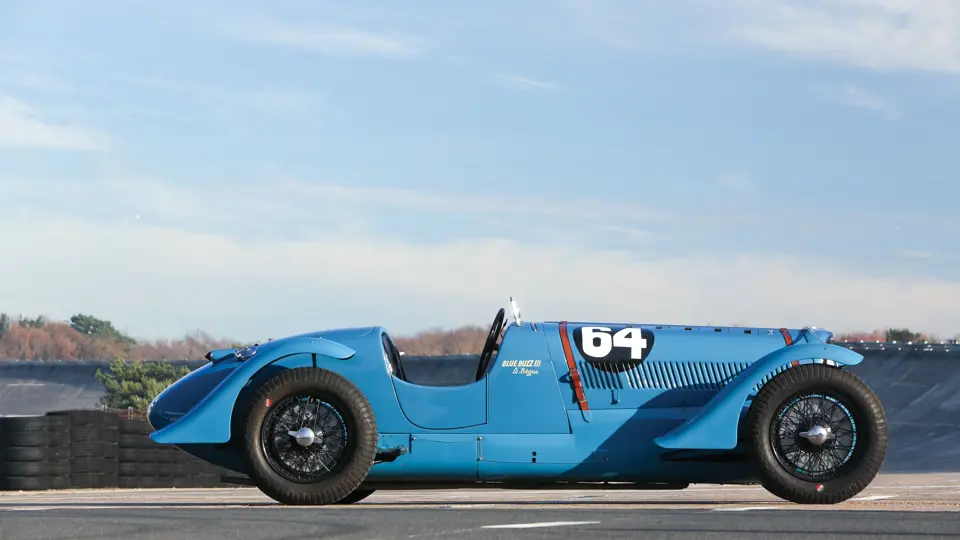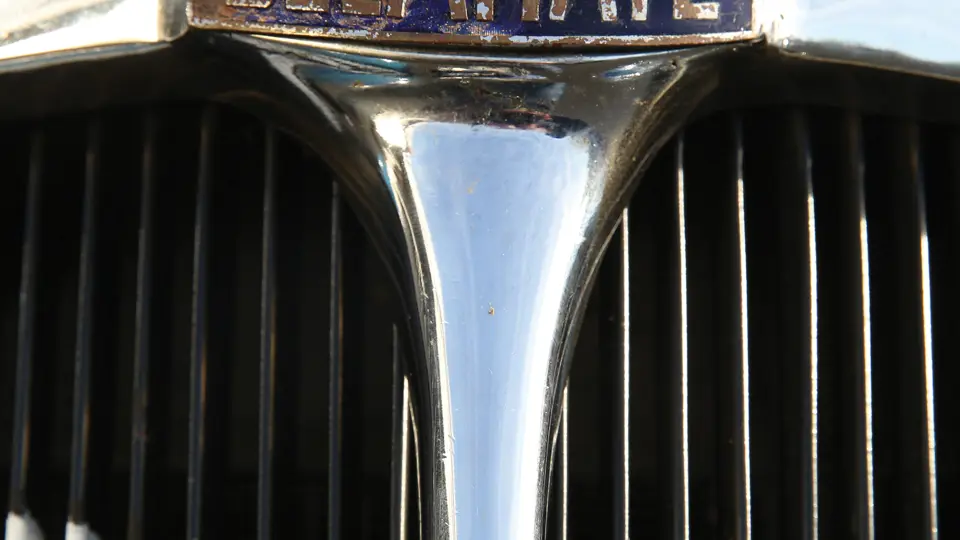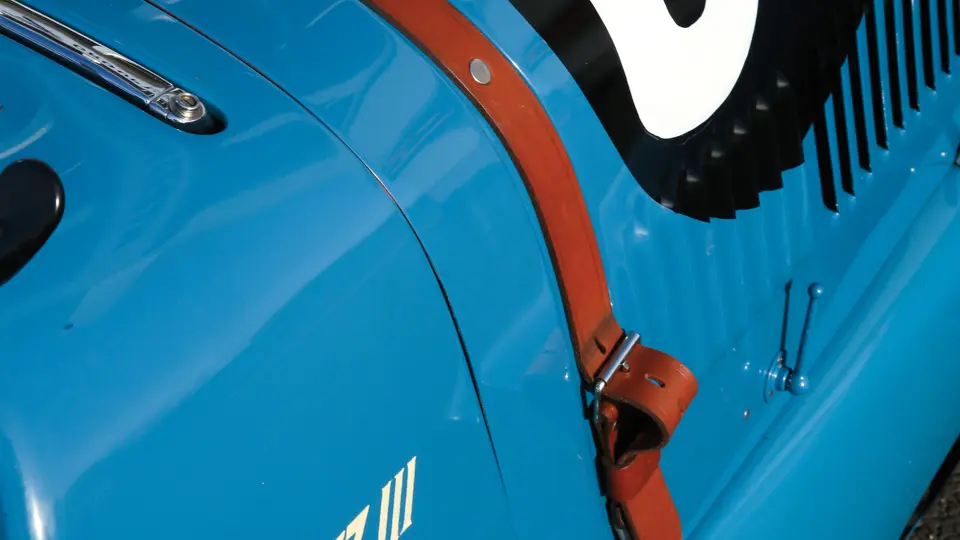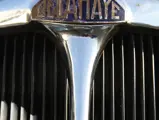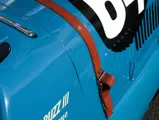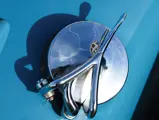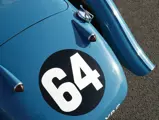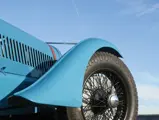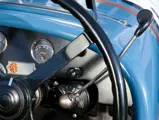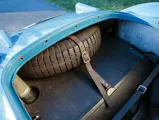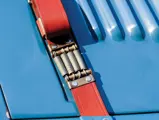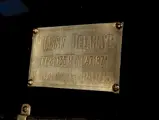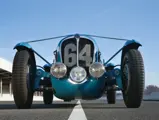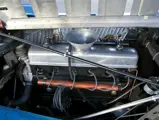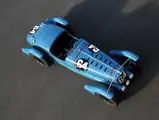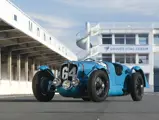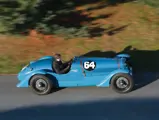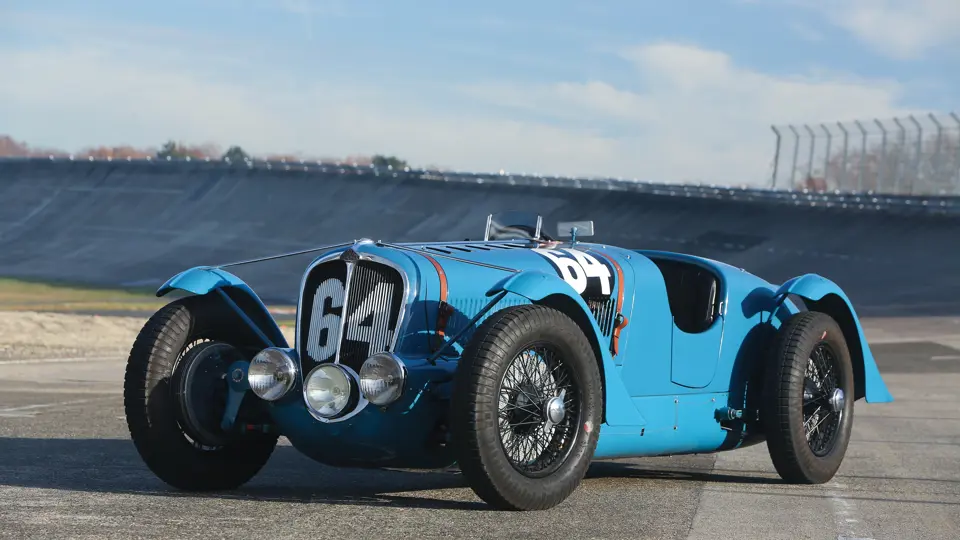
1936 Delahaye 135 S
{{lr.item.text}}
€1,008,000 EUR | Sold
{{bidding.lot.reserveStatusFormatted}}
- Unbroken ownership since new
- Painstakingly accurate restoration by marque experts in France
- One of only 16 examples constructed
- Extensively raced in period, including First Place at the 1936 24 Hours of Spa
- Perfectly sorted mechanically and delivered with valid FIA HTP
- Chaîne des propriétaires in interroup u depuis l’origine
- Restauration méticuleuse par spécialistes de la marque en France
- Une des 16 voitures construites, dont 7 ont survé cue
- Nombreux engagements en course avant et après-guerre dont une 1e place aux 24 Heures de Spa 1936
- Mécaniquement parfaite et livrée avec ses papiers FIA HTP valides
Est. 160 bhp 3,557 cc inline six-cylinder engine, four-speed Cotal racing gearbox, independent front suspension with transverse leaf springs and Raxef friction dampers, live rear axle with semi-elliptic leaf springs and Raxef friction dampers, and Duo-servo four-wheel cable-operated light alloy drum brakes. Wheelbase: 2,700 mm
Moteur six cylindres en ligne à soupapes en tête, 3 557 cm3, 160 ch (estimé), boîte de vitesse électromagnétique Cotal course « 38 m.kg » à 4 rapports, suspension avant indépendantes par ressort à lames transversal et amortisseurs à friction Raxef, pont arrière rigide oscillant sur ressorts à lames semi-elliptiques et amortisseurs à friction Raxef, quatre freins Duo-servo commandés par câbles, tambours en alliage léger. Empattement: 2 700 mm.
The vehicles for Delahaye’s new direction were the Superluxe and its sports sibling, the Delahaye Type 135. The Superluxe’s and Type 103’s engine, a long-stroke, pushrod-operated overhead valve, four-main-bearing F-head inline six, was designed by Jean François, under the direction of Delahaye’s technical director, Amédée Varlet, and it would become one of the most versatile, long-lived engine designs in history.
At the same time, Delahaye engineer Jean François was hard at work on a new chassis, the Type 135, to complement the more powerful engine. The chassis was a particularly advanced assembly for its time, with boxed rectangular rails, a central crossmember, and a welded-in floor, which contributed to additional stiffness and rigidity. The front suspension was independent, using its transverse leaf spring as the lower control arm.
Introduced at the 1953 Paris Salon, the road going version of the Type 135 was offered with two engine sizes and two aspiration options, yielding a choice of 95 horsepower, 120 horsepower, and two 110 horsepower configurations. The competition prospects for the Type 135 were embodied in a fifth model, the short-wheelbase Delahaye Type 135 Special that had a 3,557-cubic centimetre engine with triple carburettors, which could produce 160 horsepower. The Type 135 Special was more than just highly tuned, as it also featured additional engine block cooling passages, a lighter and better balanced crankshaft that was capable of higher rpms, an 8.4:1 compression ratio cylinder head, a modified valve gear, and a high-lift cam. It breathed through three horizontal Solex carburettors and had six exhaust ports with individual exhaust header pipes.
All the Type 135 Specials were bodied with similar lightweight, two-seat coachwork with removable teardrop wings, making them acceptable in both sports car and grand prix competition. They were aggressively functional, gracefully styled, and effectively aerodynamic, and their rugged, naturally aspirated engines and dual-purpose functionality made the Delahaye Type 135 Special the ideal race car for the 1936 French racing season.
The Automobile Club de France had proposed a series of French races for “sport-competition” cars, which were designed to avoid the dominance of German and Italian marques in grand prix. Included in the ACF’s schedule, in addition to the 24 Hours of Le Mans, was the French Grand Prix, which was the proudest laurel any French auto manufacturer could win.
The French Grand Prix was held at Montlhèry, outside Paris, on 28 June, over a distance of 1,000 kilometres. The Delahaye Type 135 Specials threw a scare into Bugatti, finishing 2nd through 5th behind Wimille and Sommer in an envelope-bodied Bugatti Type 57G. Albert Perrot, with co-driver Dhome, finished 5th, just behind Laury Schell and René Carrière. Schell had finished 2nd in the 3 Hours of Marseilles, which was held a month before on the Miramas circuit, in a sweep of the top six positions by Delahaye Type 135 Specials. Two weeks after the French GP, Schell and Carrière finished 3rd overall at the 24 Hours of Spa. Delahaye’s hopes of adding the victory wreath from the 24 Hours of Le Mans to the company’s history was unfortunately interrupted by 1936’s social and labour unrest in France, which forced the cancellation of the endurance classic.
Chassis 47187 started life with a two-seater sport body by O. Lecanu-Deschamps in Levallois, Paris, France. It was purchased new in the spring of 1936 by the young Rene Le Begue, along with chassis 46075, a Competition Court chassis. He immediately began to campaign the car, entering it in the 3 Hours of Marseilles on 13 May and no fewer than 12 events throughout the 1936 season, all wearing the registration plate 2204 YB 6. Notable amongst these entries were the 24 Hours of Le Mans on 13 June, but, unfortunately, the race was cancelled due to social unrest. Following this was the Grand Prix de l’A.C.F., which was an important event due to the overwhelming presence of nine Delahayes on the grid, and there Le Begue managed to qualify 3rd.
As Le Mans was cancelled, many teams shifted their focus to the 24 Hours of Spa. At the event there were categories A and B, which represented supercharged cars and those which were naturally aspirated, respectively; each of these categories was further subdivided into five classes that were based on displacement. The day was hard fought, with torrential rain to boot, but in the end, Le Begue and 47187 emerged victorious, finishing 1st in the two-to-four-litre class, first in Category A, and 2nd overall behind the powerful, supercharged 8C 2900 Alfa of Sommer and Severi.
At the Grand Prix du Comminge in August, the car did well, finishing 4th overall and 1st amongst the seven 135 Specials present on the track. Next came the Tourist Trophy, held on 5 September in Belfast, which is a notable entry because this is the first time that 47187 appeared with white wheels, a white dash and steering wheel, and the “Blue Buzz III” moniker painted on the cowl. In the qualifying rounds, Le Begue earned the pole position and took a quick lead out of the muddy starting grid, achieving the fastest lap time at a recorded 137.658 km/h. Unfortunately, he did not finish this race due to electrical issues.
After participating in the Mount Ventoux Hill Climb, the car travelled to England for the Donington Grand Prix on 3 October, where there was a big showdown, which saw supercharged Alfas, Maseratis, Bugattis, and ERA against the naturally aspirated Delahayes. Being in the UK, Le Begue also took the opportunity to travel to Brooklands for testing trials in order to best calibrate his machine. At the end of the 1936 season, Le Begue was hired by Ecurie Talbot, resulting in the ownership of 47187 being passed to Count Pierre Merlin, with registration number 2339 RK 8.
Due to a change of regulations, the car was fitted with a proper door, as were all of the other similarly bodied sports racers. Under Merlin’s ownership, the 135 S was entrusted to Raphael “Ralph” Bethenod de Las Casas, who placed 5th overall at the Grand Prix de Pau on 21 February and 3rd overall at the Coupe de Printemps in Montlhery. Merlin himself piloted the car in the 3 Hours of Marseilles, which would be the last event that the car was campaigned in in its original two-seater sport configuration.
At the end of the 1937 season, Merlin decided to use the Delahaye as a road car, and he had it rebodied into a roadster, which was more appropriate to his new intended use. On 27 June 1946, the car was sold to Miss Schwob de Lure, of Paris, who maintained the same registration number. At the end of 1947, de Lure sent the car to the coachbuilding shop of Jules Grignard in Enghien. The result of Grignard’s efforts was a cabriolet very much of the school of Figoni et Falaschi, and it was entered into the Concours d’Elegance of Enghien-les-Bains on 2 June 1948.
Miss Schwob sold the car shortly thereafter, and it passed through a short succession of known owners, with one of whom commissioning a berlinetta body by Henri Molla. In 1958, it was eventually acquired by George Marut with the intent to race. Marut entered the Delahaye into the Course de Cote de Limonest - Mont Verdun on 27 September 1959, and he finished 13th overall and 4th in class. Following Marut’s ownership, the Delahaye ultimately came into the possession of Charles Sadoyan, who would retain the car for four decades, from 1964 through to 2004, when it was acquired by the present owner.
In 2005, the owner made the decision to return the car to its 1937 specification, and the work was entrusted to Carrosserie Francois Cointreau. His efforts were greatly aided by Bernard Brule, a designer and engineer at Peugeot, who painstakingly created all of the necessary engineering drawings to make the project a reality. The blueprints he created were as accurate as possible, as they were based on all available period photography, as well as the original 135 S plan pour carrossier (factory chassis plans for coachbuilders), which were supplied by well-known expert Christian Huet. From Brule’s blueprints, wooden body bucks were created and metal was sculpted over a frame of ash, and the racing Delahaye of Le Begue came back to life.
When the painstakingly created body was completed and placed onto the original chassis, it was aligned directly with the original bolt holes from the original body. The engine has been mechanically sorted by Fred Novo, a specialist well-known for his expertise with such great pre-war French racing cars as Bugatti, Delahaye, Delage, and Hispano Suiza. As such, it is unequivocally offered “on the button”. The engine has been tuned to racing specification, with high compression pistons, a hot camshaft, and other items, so that the output is likely higher than the 160 horsepower of the original 135 S engine. The life of 47187 has been heavily documented by Christian Huet, and a file of two binders that comprise a great deal of history and restoration documentation should be reviewed by all parties interested in this lot.
Today, it is believed that 7 of the 16 original Delahaye Type 135 Specials survive, which is ample evidence that enthusiasts recognised even in the darkest days of World War II that these were exceptional automobiles of the highest quality and rare distinction.
Chassis 47187 was built from its inception as a dual-purpose grand prix and sports car, making it adaptable to, and acceptable for, all of the most important and enjoyable events and tours. The Type 135 Special has scored points in grand prix, sports car, and endurance events, and it has been driven by legends in racing history. This Type 135 is beautifully presented and carefully prepared, and it would make a fabulous addition to the stable of the French racer.
Competition history for this car can be found in both our print and digital catalogues.
La voiture qui concrétisa la nouvelle orientation de Delahaye fut le modèle Superluxe et son dérivé sportif surbaissé, la Delahaye Type 103. Conçue par l’ingénieur Jean François sous la supervision du directeur technique de Delahaye, Amédée Varlet, la Superluxe et le moteur type 103, un six cylindres monobloc « longue course » à culbuteurs et soupapes en tête en ligne, à quatre paliers, allaient vivre une longue et glorieuse aventure.
À la même époque, Jean François consacra de longues études à un nouveau châssis, le Type 135, destiné à exploiter au mieux des versions du moteur les plus puissantes. Ce châssis était une structure très moderne en son temps avec des longerons tubulaires rectangulaires, une traverse caissonnée centrale et un plancher soudé qui ajoutait à la rigidité et à la résistance du cadre. La suspension avant à roues indépendantes utilisait le ressort transversal comme bras de liaison inférieur.
Introduit au salon de Paris 1935, le Type 135 offrait au choix des système d’admission à un ou trois carburateurs outre deux moteurs de capacités différentes, un 18 CV de 3 227 cm3 et un 20 CV de 3 557 cm3 donnant aux acheteurs un choix de configurations ; 95 ch, 120 ch et deux versions de 110 ch.
La version routière du Type 135 était donc proposée avec deux moteurs au choix et deux systèmes d’admission en option donnant les mêmes possibilités : 95 ch, 120 ch ou 110 ch. Mais les projets dans le domaine de la compétition pure avec le Type 135 étaient servis par un cinquième modèle : le châssis le plus court avec le moteur 3 557 cm3 à trois carburateurs c’est-à-dire le Type 135 Spécial de 160 ch. Plus que simplement préparé, le Type 135 Spécial se caractérisait par un bloc cylindre pourvu de passages d’eau supplémentaires, un vilebrequin mieux équilibré et allégé capable de prendre des tours plus vite, un diagramme de distribution modifié et des cames à grande levée. Il était alimenté par trois carburateurs horizontaux Solex et la culasse offrait six orifices d’échappement avec sorties séparées.
Tous les châssis Type 135 Spécial furent habillés de la même caisse légère biplace et d’ailes amovibles en goutte d’eau, permettant ainsi de courir en Grand Prix comme en Sport. Agressivement fonctionnelles, élégamment proportionnées et surbaissées et d’une aérodynamique correcte, ces voitures au robuste moteur atmosphérique se révélèrent polyvalentes au point de faire du Type 135 Spécial la machine idéale pour la saison de course 1936 en France.
L’Automobile Club de France s’était proposé d’organiser une série de courses réservées aux voitures « sport-compétition » dans le but de contrer la domination en Grands Prix des voitures allemandes et italiennes. Le calendrier du Club avait prévu selon cette formule, outre les 24 Heures du Mans, le Grand Prix de l’ACF, la plus belle victoire aux yeux des constructeurs français.
Le Grand Prix de l’ACF fut couru à Montlhéry au sud de paris le 28 juin sur une distance de mille kilomètres. Les Delahaye Type 135 Spécial s’insinuèrent entre les Bugatti en se plaçant de la deuxième à la cinquième place derrière Wimille et Sommer au volant d’un « Tank » Bugatti 57 G. Albert Perrot qui faisait équipage avec Dhome finit cinquième juste derrière Laury Schell et René Carrière. Un mois avant, Schell avait terminé deuxième aux 3 Heures de Marseille courues sur le circuit de Miramas où les six Delahaye 135 Spécial avaient raflé les six premières places. Deux semaines après le GP de l’ACF, Schell et Carrière arrivèrent trosièmes des 24 Heures de Spa en Belgique. Les espoirs de Delahaye d’ajouter au palmarès de la marque un triomphe aux 24 Heures du Mans furent déçus en raison des grèves et des troubles sociaux qui paralysèrent la France et qui entraînèrent l’annulation de la course.
Le châssis n° 47187 commença sa carrière habillé d’une caisse biplace réalisé par O. Lecanu-Deschamps, carrossier à Levallois, près de Paris (France). Il fut acheté au pritemps 1936 par le jeune René Le Bègue en même temps que le n° 46075, un châssis « Compétition Court ». Il l’engagea immédiatement en participant aux 3 Heures de Marseille le 13 mai et en ne prenant pas moins de 12 engagements tout au long de la saison 1936, toujours sous l’immatriculation 2204 YB6. On note parmi ses engagements les 24 Heures du Mans le 13 juin, mais cette course fut annulée en raison des grèves. Suivit le Grand Prix de l’ACF, un événement important en raison de la présence sur la grille de 9 Delahaye et où Le Bègue se qualifia en troisième position.
En raison de l’annulation du Mans, de nombreuses écuries reportèrent leur effort sur les 24 Heures de Spa. Cette épreuve réunissaient des voitures des catégories A et B, celles à compresseur et les « atmosphériques » elles-mêmes subdivisées en cinq catégories en fonction de leur cylindrée. La course fut très disputée sous la pluie, mais à la fin, Le Bègue et 47187 s’imposèrent à l’arrivée en terminant premiers de la catégorie « 2 à 4 litres », premiers de la catégorie A et en prenant la deuxième place au général derrière la surpuissante Alfa Romeo 8C 2900 à compresseur de Sommer et Severi.
Au Grand Prix du Comminges en août, la voiture marcha bien et termina 4e au général et première des sept 135 Spécial présentes au départ. Vint ensuite le Tourist Trophy couru le 5 septembre à Belfast, engagement notable car pour la première fois, 47187 apparut avec des roues blanches, une planche de bord blanche et un volant blanc et le surnom « Blue Buzz III » peint sur l’auvent. Aux qualifications, Le Bègue prit la pole position, puis un bon départ malgré une piste détrempée pour réaliser le meilleur tour avant d’être arrêté par des problèmes électriques.
Après une participation à la course de côte du Mont Ventoux, la voiture partit pour le Grand Prix de Donington le 3 octobre où se produisit la grande confrontation entre les Alfa, Maserati, Bugatti et ERA à compresseur et les Delahaye atmosphériques. Profitant de son séjour en Angleterre, Le Bègue se rendit à Brooklands pour y procéder à des essais en vue de calibrer sa voiture. A la fin de la saison 1936, Le Bègue fut recruté par l’Ecurie Talbot et 47187 devint la propriété du comte Pierre Merlin sous le numéro d’immatriculation 2339 RK8.
En raison d’un changement de règlement, la voiture fut équipée d’une porte comme toutes les autres machines sport-compétition. Aux mains de Merlin, la 135 S fut confiée à Raphaël « Raph » Béthenod de Las Casas qui prit la 5e place au GP de Pau le 21 février 1937 et la 3e au général de la Coupe de Printemps à Montlhéry. Merlin pilota lui-même la voiture aux 3 Heures de Marseille, dernière épreuve disputée par la voiture sous sa forme originale de biplace sport de compétition.
À la fin de la saison 1937, Merlin décida d’utiliser la Delahaye comme une routière et la fit recarrosser en roadster mieux adapté à cet usage. Le 27 juin 1946, la voiture vendue à Mlle Schwob de Lure à Paris conserva le même numéro d’immatriculation. À la fin de 1947, de Lure envoya la voiture à l’atelier de carrosserie de Jules Grignard à Enghien. Le résultat du travail de Grignard fut un cabriolet très inspiré par Figoni et Falaschi qui fut inscrit au Concours d’Elégance d’Enghien-les-Bains du 2 juin 1948.
Mlle Schwob vendit la voiture peu après et celle-ci passa aux mains de plusieurs propriétaires identifiés dont l’un commanda une caisse de berlinette à Henri Molla. Elle fut ensuite achetée en 1958 par Georges Marut dans l’intention de courir. Marut engagea la Delahaye à la course de côte de Limonest-Mont Verdun le 27 septembre 1959 où il finit 13e au général et 4e de sa catégorie. Après avoir été la propriété de Marut, la Delahaye finit par arriver chez Charles Sadovan qui la conserva pendant quarante ans, de 1964 à 2004, date à laquelle elle fut acquise par le propriétaire actuel.
En 2005, le propriétaire prit la décision de remettre la voiture dans sa configuration de 1937. Les travaux furent confiés à la Carrosserie François Cointreau qui bénéficia d’une aide considérable de la part de Bernard Brulé, styliste et ingénieur chez Peugeot. Celui-ci retraça méticuleusement tous les plans techniques nécessaires à la réalisation du projet. Ces plans furent dessinés avec la plus grande précision possible sur la base des photos d’époque disponibles ainsi que du « plan pour carrossier » original du châssis 135 S fourni par l’expert bien connu Christian Huet. D’après les plans de Brulé, les pièces de bois furent fabriquées et les tôleries formées sur le mannequin de bois de frêne et la Delahaye de course de Le Bègue ressuscita.
Lorsque la carrosserie patiemment recréée fut achevée et posée sur le châssis original, ses fixations s’alignèrent parfaitement sur les perçages des boulons de la caisse originale. Le moteur, remis en état par Fred Novo, spécialiste bien connu pour ses compétences en matière de voitures de course françaises d’avant-guerre comme les Bugatti, Delahaye, Delage et les Hispano-Suiza, est donc déclaré capable de démarrer « au quart ». Il a été mis au point selon les spécifications « course » avec des pistons haute compression, un arbre à cames spécial et autres pièces de performance si bien qu’il est crédité d’une puissance supérieure aux 160 ch du moteur d’origine. L’existence de 47187 a été solidement documentée par Christian Huet et un dossier comportant deux classeurs qui retrace la plus grande partie de son histoire et de sa restauration doit être consulté par tous ceux qui s’intéressent à ce lot.
De nos jours, on estime que 7 des 16 Delahaye Type 135 S originales survivent, preuve que les passionnés ont toujours reconnu, même dans la période la plus sombre de la Seconde Guerre mondiale, que ces automobiles exceptionnelles étaient de la plus haute qualité et d’une rare distinction.
Construit dès sa conception à la fois comme une voiture de Grand prix et une voiture de sport, le châssis 47187 est à sa place dans les plus importants événements routiers et sportifs historiques qui l’accueilleront sans réserve. Le Type 135 Spécial a brillé en Grands Prix, en endurance et en rallyes, piloté par des légendes vivantes de l’histoire de la course. Magnifiquement présenté et méticuleusement préparé, il ne peut être que le prestigieux fleuron de toute collection de machines de course françaises.
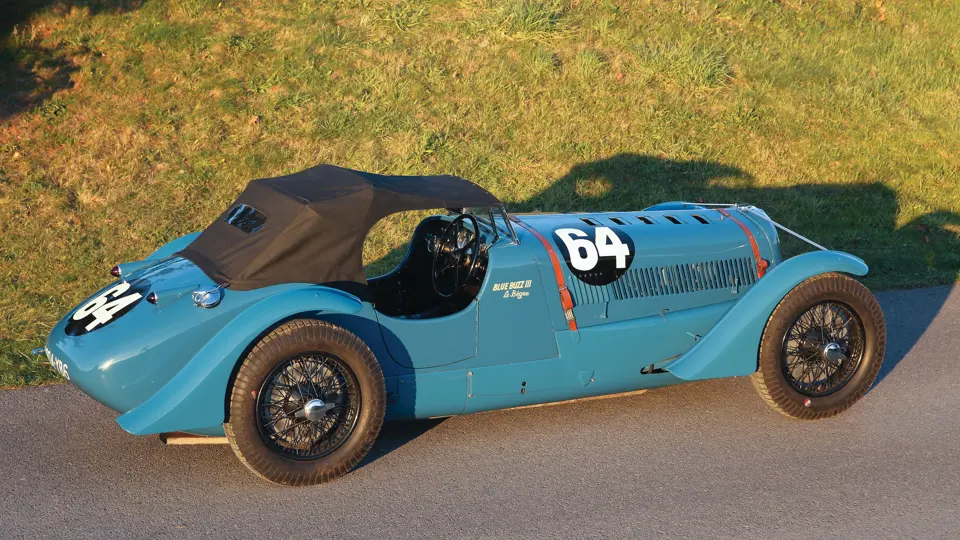




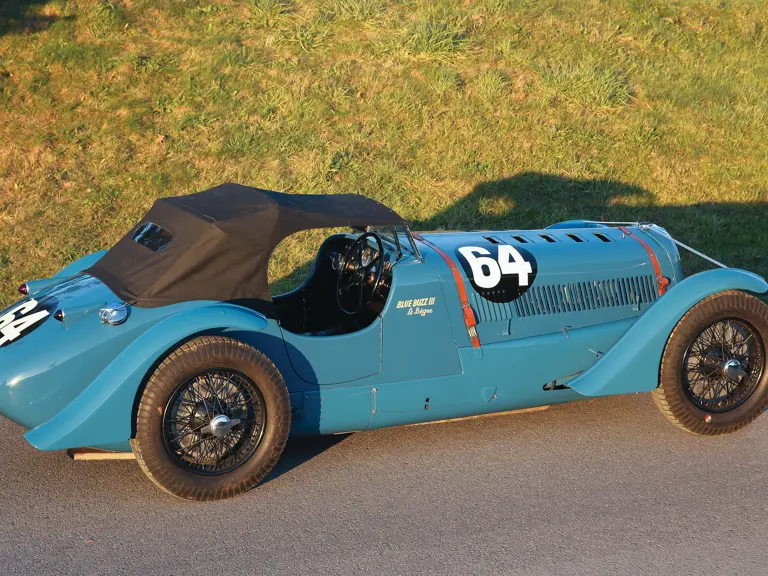



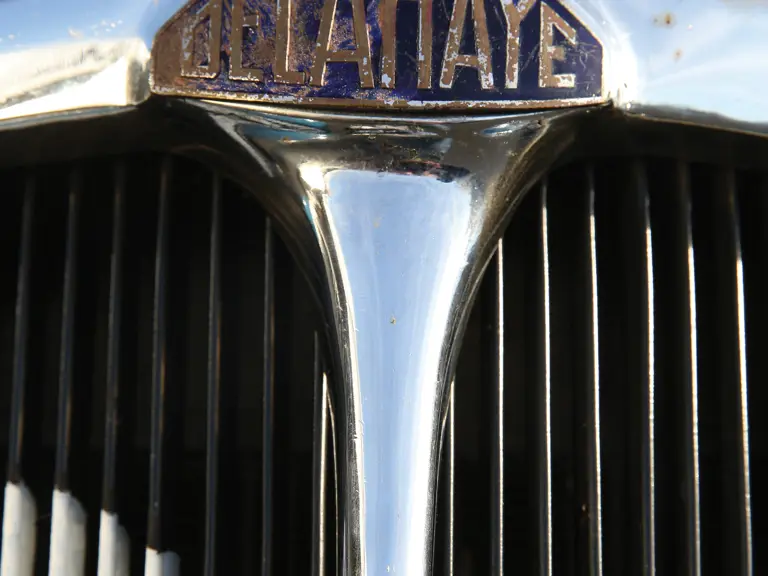



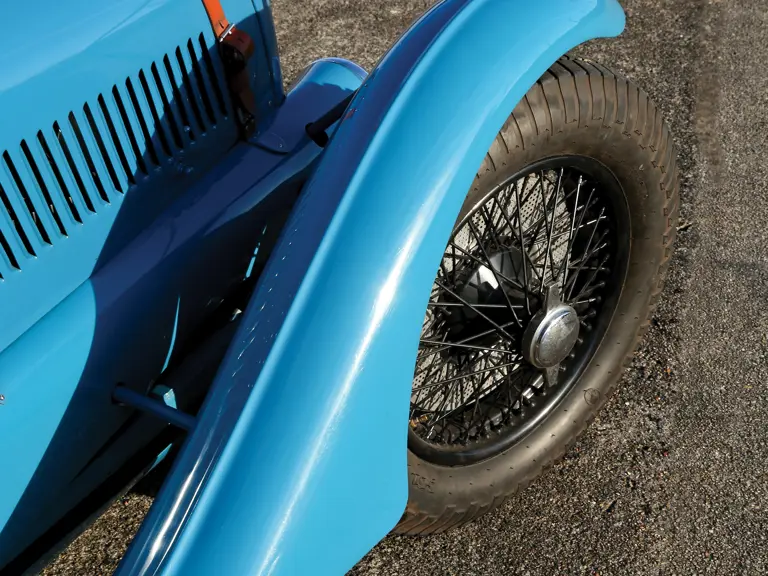

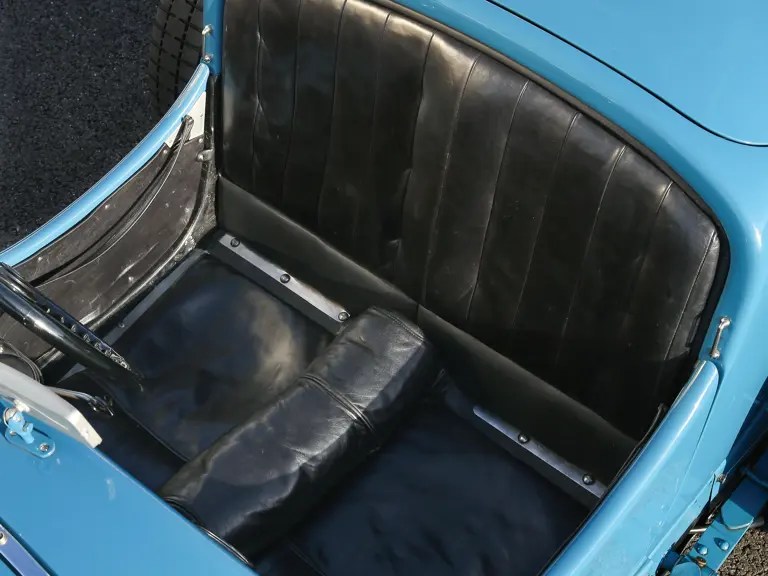

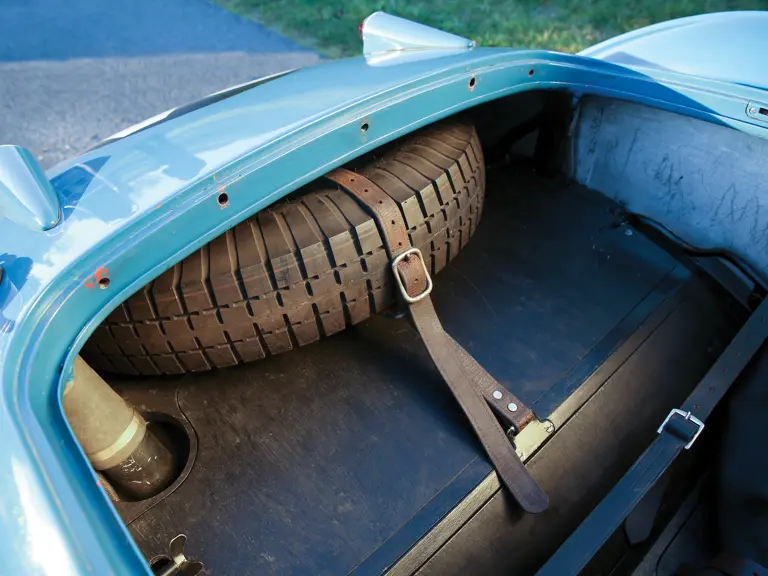





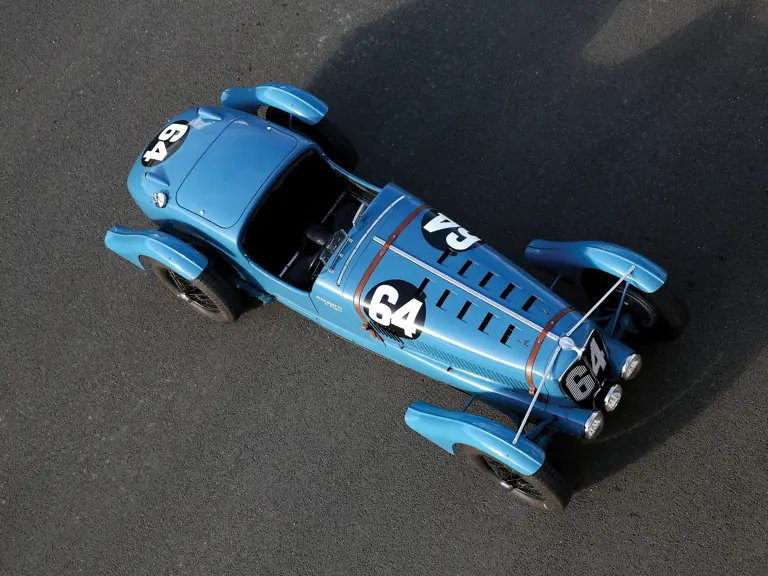
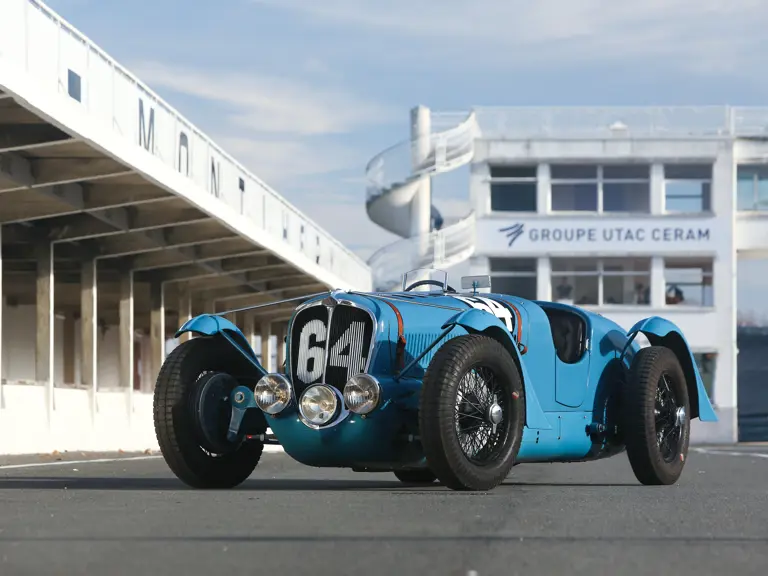
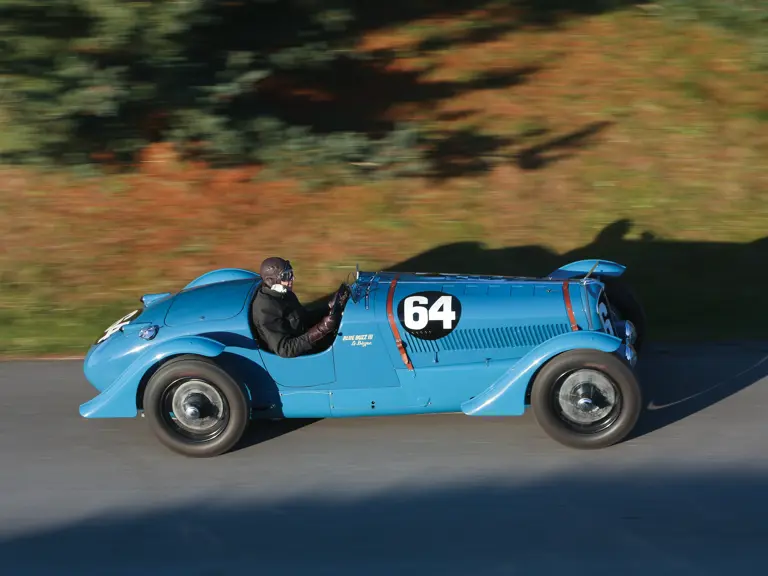
 | Paris, France
| Paris, France
